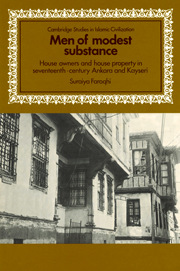Book contents
- Frontmatter
- Contents
- Tables
- Graphs
- Illustrations
- Figures
- Abbreviations
- Preface
- Introduction
- 1 Setting the scene: two cities of central Anatolia
- 2 The physical shape of urban houses
- 3 The cost of buying a house
- 4 Urban property-owners
- 5 The difficulties of an urban property-owner
- Conclusion
- Glossary
- Notes
- Bibliography
- Index
2 - The physical shape of urban houses
Published online by Cambridge University Press: 18 November 2009
- Frontmatter
- Contents
- Tables
- Graphs
- Illustrations
- Figures
- Abbreviations
- Preface
- Introduction
- 1 Setting the scene: two cities of central Anatolia
- 2 The physical shape of urban houses
- 3 The cost of buying a house
- 4 Urban property-owners
- 5 The difficulties of an urban property-owner
- Conclusion
- Glossary
- Notes
- Bibliography
- Index
Summary
Terminology
In sixteenth and seventeenth century Ankara or Kayseri, a house was usually known as menzil, or more simply as ev. More ambiguous was the term mülk (‘freehold property’). For when referring to the properties bordering a given house, the documents commonly call the former ‘mülk of N.N.’. Given the fact that in a residential neighbourhood most pieces of land not explicitly described as serving a different purpose must have been occupied by houses, one might assume that the word mülk was in this context used for purposes of clarification. Thus a ‘mülk menzil’, a term which frequently recurs in the documents, means a ‘house held as freehold property’. Therefore, it appears more appropriate to translate the term mülk ‘property’.
A mülk menzil regularly consisted not only of a building but of a courtyard as well, while it was quite rare to find a garden (bahçe) attached to the house. For the courtyard, different terms were in current use. In late sixteenth and early seventeenth Kayseri, the most frequently used expression was muhavvata (‘enclosed’) or else a term which appears to be ‘havlu’ and should correspond to the modern Turkish avlu. On the other hand, Ankara documents of the 1590s and early 1600s frequently refer to a hayat. Now in modern Turkish parlance, a hayat is not a courtyard but a veranda. One might thereby conclude that Ankara houses usually possessed no courtyard, if it were not for the fact that occasionally trees are mentioned as growing in the hayat. Now one may discount the unlikely possibility that somebody had been raising a potted pear tree on his veranda, and that the fact somehow got included into the description of the house.
- Type
- Chapter
- Information
- Men of Modest SubstanceHouse Owners and House Property in Seventeenth-Century Ankara and Kayseri, pp. 65 - 115Publisher: Cambridge University PressPrint publication year: 1987



